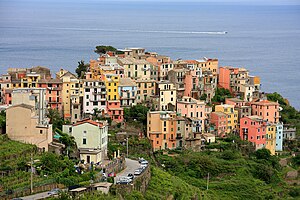Corniglia
| Corniglia | |||
|---|---|---|---|

|
|||
| view | |||
| Country | Italy | ||
| region | Liguria | ||
| province | La Spezia (SP) | ||
| local community | Vernazza | ||
| Coordinates | 44 ° 7 ' N , 9 ° 42' E | ||
| height | 90 m slm | ||
| Residents | 245 () | ||
| Demonym | Cornigliesi | ||
| patron | San Pietro | ||
| Telephone code | 0187 | CAP | 19010 |
Corniglia is one of the five villages of the Cinque Terre . The town, which has about 250 inhabitants, is politically a fraction (district) of the municipality of Vernazza in the Ligurian province of La Spezia , Italy . As the only village in the Cinque Terre, it is not located directly on the sea, but on a ledge at a height of about 100 m, surrounded by three large vineyards and a steep cliff facing the sea.
The car-free village center, marked by narrow streets, extends along the main street Via Fieschi . The houses face this street and the sea on the other side.
Corniglia is mentioned in a famous novella Decameron by Giovanni Boccaccio .
traffic
Corniglia has a railway station on the Pisa – Genoa railway line . The place can be reached from the lower station via the Lardarina , a long brick staircase .
history
The origin of the village goes back to Roman times, confirmed by the name, which has its roots in the gens Cornelia . In the Middle Ages, Corniglia was owned by Lavagna , the rulers of Luna and Carpena . In 1254 Pope Innocent IV gave it to his brother Nicolò Fieschi until it was captured by the Republic of Genoa in 1276 .

